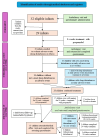Assessing Response Rates and Sleep Disorder Prevalence: Insights from a Propranolol Treatment Study for Infantile Haemangiomas
- PMID: 39334619
- PMCID: PMC11430174
- DOI: 10.3390/children11091086
Assessing Response Rates and Sleep Disorder Prevalence: Insights from a Propranolol Treatment Study for Infantile Haemangiomas
Abstract
Background: Infantile haemangiomas (IHs) sometimes require treatment with propranolol. Sleep disturbances are the most frequently reported side effects. Monitoring adverse drug events necessitates repeated hospital visits, which can be challenging during a pandemic.
Objectives: To explore the effectiveness of a new electronic questionnaire in identifying sleep disturbances related to treatment with propranolol and potential confounding factors. To evaluate the response rate to the questionnaire. To report the proportion of patients on propranolol with sleep disturbances.
Methods: In an observational, prospective cohort study, caregivers provided clinical information during ambulatory visits and via an electronic questionnaire after an 8-week treatment course with propranolol and at the time of treatment interruption. Adverse drug reaction reporting forms were assessed for causality.
Results: The questionnaire response rate was 91%, and the completion rate was 100%. A total of 59% of patients experienced sleep disturbances during propranolol treatment, which were considered adverse reactions. Sleep disorders were frequent during sleep regression phases and in subjects who fell asleep during physical contact with caregivers or bed-sharing with parents.
Conclusion: The application of this questionnaire allows for identifying adverse sleep events associated with propranolol in IHs and potential confounders. Counselling on sleep hygiene is recommended before treatment onset.
Keywords: children; electronic questionnaire; infantile haemangiomas; infants; propranolol; sleep disturbances.
Conflict of interest statement
The authors declare no conflicts of interest.
Figures
Similar articles
-
Propranolol (Hemangiol) and severe infantile haemangiomas. The drug of first choice.Prescrire Int. 2015 Jul;24(162):173-6. Prescrire Int. 2015. PMID: 26240880
-
Oral Nadolol for Children with Infantile Hemangiomas and Sleep Disturbances with Oral Propranolol.Pediatr Dermatol. 2015 Nov-Dec;32(6):853-7. doi: 10.1111/pde.12686. Epub 2015 Oct 8. Pediatr Dermatol. 2015. PMID: 26447831
-
The effectiveness of propranolol in treating infantile haemangiomas: a meta-analysis including 35 studies.Br J Clin Pharmacol. 2014 Jul;78(1):44-57. doi: 10.1111/bcp.12235. Br J Clin Pharmacol. 2014. PMID: 24033819 Free PMC article. Review.
-
Use of propranolol for treatment of infantile haemangiomas in an outpatient setting.J Paediatr Child Health. 2012 Oct;48(10):902-6. doi: 10.1111/j.1440-1754.2012.02521.x. Epub 2012 Aug 16. J Paediatr Child Health. 2012. PMID: 22897120
-
[Propranolol therapy for periocular and orbital infantile haemangiomas].Klin Monbl Augenheilkd. 2014 Oct;231(10):971-9. doi: 10.1055/s-0034-1383088. Epub 2014 Oct 21. Klin Monbl Augenheilkd. 2014. PMID: 25333232 Review. German.
Cited by
-
An endothelial SOX18-mevalonate pathway axis enables repurposing of statins for infantile hemangioma.J Clin Invest. 2025 Feb 25;135(7):e179782. doi: 10.1172/JCI179782. J Clin Invest. 2025. PMID: 39998898 Free PMC article.
-
Efficacy and safety assessment of propranolol tablets vs. oral solution for infantile hemangioma: a retrospective study in China.Front Pediatr. 2025 Feb 4;13:1542348. doi: 10.3389/fped.2025.1542348. eCollection 2025. Front Pediatr. 2025. PMID: 39967746 Free PMC article.
References
-
- Solman L., Glover M., Beattie P.E., Buckley H., Clark S., Gach J.E., Giardini A., Helbling I., Hewitt R.J., Laguda B., et al. Oral propranolol in the treatment of proliferating infantile haemangiomas: British Society for Paediatric Dermatology consensus guidelines. Br. J. Dermatol. 2018;179:582–589. doi: 10.1111/bjd.16779. - DOI - PubMed
LinkOut - more resources
Full Text Sources


